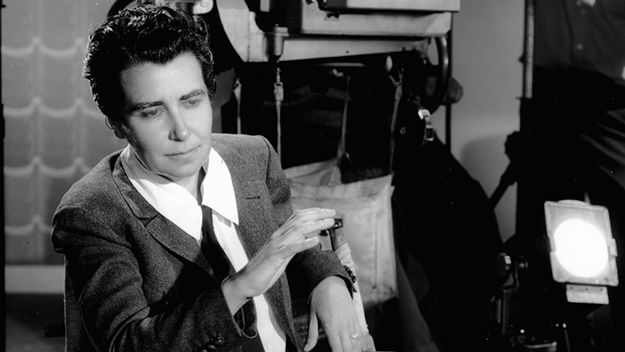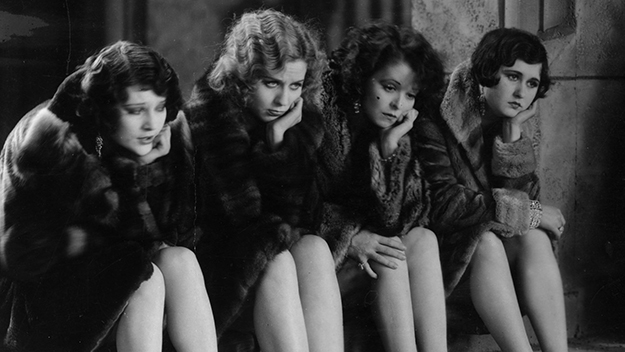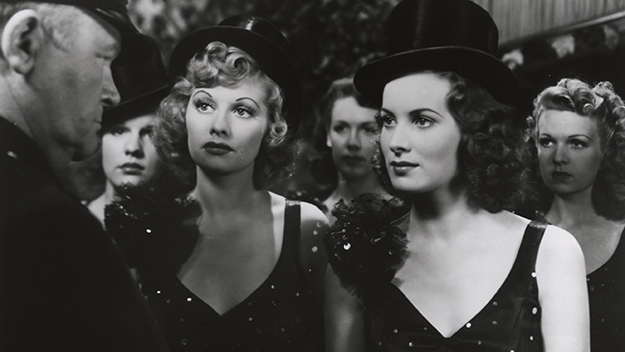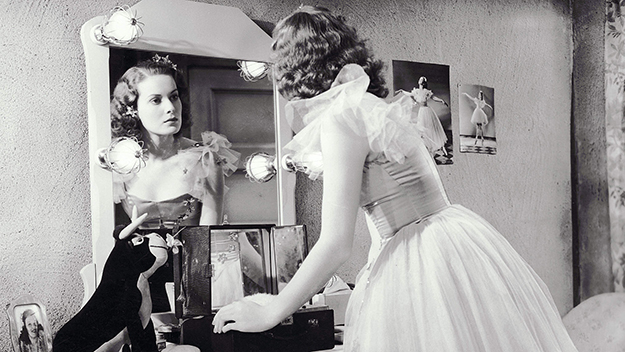Queer & Now & Then: 1940
In this biweekly column, I look back through a century of cinema for traces of queerness, whether in plain sight or under the surface. Read the introductory essay.

Dorothy Arzner
For those who’ve heard it, the name Dorothy Arzner emblazons in the dark like neon; no other light touches her. She’s an emblem of both invisibility and presence: her name is invoked either when someone is making a point about the lack of female directors in Golden Age Hollywood, or conversely as evidence that they did indeed exist. Arzner’s achievements cannot be overestimated, but she remains undervalued in the culture at large. There may have been others dotting the horizon, but Arzner was the only consistently working female director in the studio system during the industry’s first decade of sound, making 16 movies in a career that lasted from 1927 to 1943.
Yet alongside Arzner’s impressive, singular status as a woman in a notorious boys’ club—one that persists to this day—is the fact that she was also a lesbian filmmaker. She may not have been “out” in the way we now define that term, but by all accounts Arzner was able to remain thoroughly herself in her professional sphere, and was in a loving relationship with dancer Marion Morgan the entire time she worked in Hollywood and all the way into the 1970s. As was the case with so many other technically closeted artists in the industry, Arzner’s homosexuality was something of an open secret, and while public discussion of it would have been out of the question, her forthrightly butch style—tailored suits, slicked-back short hair, thick eyebrows—indicated her clear disinterest in traditional ideas of femininity. In a seeming contradiction, this lack of conventionally “glamorous” attributes was an asset: it granted her a certain amount of acceptance into a world in which projections of masculinity are prized above all.
After studying medicine at USC, the California-born Arzner decided the field wasn’t for her, and through connections made as a medical volunteer during World War I, found herself invited to visit Adolph Zukor’s movie studio Famous Players-Lasky, later to become Paramount. Arzner was immediately taken with the environment, and in 1919 began a series of apprenticeships, from typist to script supervisor to cutter to scriptwriter. Finally, after working her way up through the ranks, she was entrusted with directing her first film for Paramount in 1927, Fashions for Women, starring up-and-comer Esther Ralston. Throughout this ascendance, Arzner began fostering connections to other gay women with whom she came in contact, including Russian émigré Alla Nazimova (beloved in queer cinema circles today for producing and starring in the 1923 Oscar Wilde adaptation Salomé, a Kenneth Anger favorite rumored to have an intentionally all-gay or bisexual cast). According to an interview with gay director George Cukor in the 1970s, Nazimova and Arzner had more than just a working relationship. And it was on Fashions for Women that she first met her life-long partner, Marion Morgan, who had been hired as the film’s choreographer.

The Wild Party (Dorothy Arzner, 1929)
Arzner’s status in film history as an influential industry figure who happened to be a lesbian has long left critics and academics scanning her movies for signs of queer life. Most of this has been directed at two pre-code movies: her 1929 The Wild Party, Paramount’s first sound film, which featured “It girl” Clara Bow having a ball with her girlfriends at college; and 1933’s Christopher Strong, with Katharine Hepburn as a pilot whose devotion to her aviation career supersedes her romantic life. Anyone who’s seen the latter is surely unable to forget Hepburn’s entrance at a costume party, wearing a glittering, form-fitting silver lamé moth costume, complete with skull cap and antennae—it’s an overt moment of eroticism that serves to “other” the character even as she falls into a heterosexual relationship. Yet Arzner’s most successful film, and one of her most purely entertaining, 1940’s Dance, Girl, Dance, provides a perfect case study for how a Hollywood comedy could convey a vivid queerness beneath a seemingly formula exterior.
In another filmmaker’s hands, Dance, Girl, Dance might have been the story of two man-hungry frenemies of the same dancing troupe vying for the same love interest and devolving into jealous hysterics. In Arzner’s film, however, the romance becomes marginalized—not to mention quite suspect—in relation to the central conflict, which is more directly and presently about its female characters’ professional lives. As the film opens, the camera snakes through the Palais Royale nightclub in Akron (the lithe cinematography is by Russell Metty, a workhorse who’d go on to shoot Sirk’s All That Heaven Allows and Written on the Wind, and Welles’s Touch of Evil), trying to get a glimpse of a stage populated by hoofers dancing to “Roll Out the Barrel.” Among them are our stars, Maureen O’Hara and Lucille Ball (one can only imagine the delight in seeing these two redheads side by side in Technicolor, but alas). The joint is summarily broken up for illegal gambling, and the cops accuse the women of being “accessories”—just for doing their job on the premises. It’s a fitting introduction to a film in which women are trying to live outside the control, and the gaze, of men.

Lucille Ball and Maureen O’Hara in Dance, Girl, Dance (Dorothy Arzner, 1940)
It’s in the Palais Royale that O’Hara’s good girl Judy and Ball’s sly, seen-it-all Bubbles both meet Jimmy Harris Jr. (Louis Hayward), the perpetually soused son of a wealthy father who holds a flame for his estranged wife. Whenever Judy begins to show interest in the quite unworthy Jimmy, Bubbles swoops in and steals him away, though never because she gives even the smallest whit about him. Meanwhile, though Bubbles’s apparently selfish behavior rankles Judy, this perpetual optimist seems less focused on Jimmy than her career, telling her roommate near the beginning of the film, “The only thing I really care about is dancing.” As the film continues, the true thematic conflict is revealed not as being between men and women but between different kind of dancing: traditional ballet, as embodied by Judy, and burlesque, the forte of devil-may-care Bubbles.
Overseeing all this back in New York, and becoming a kind of mouthpiece to these dichotomies, is the mistress of the troupe, Madame Basilova. As played by legendary Russian actress and Moscow Art Theatre founding member Maria Ouspenskaya, Basilova (whose name, changed in the script from Basiloff by Arzner herself, has been remarked upon by Arzner scholar Judith Mayne as subtly evoking “Nazimova”) is a kind of Arzner stand-in, a suited, stylishly masculine mother hen who watches over her girls with great care. Basilova bemoans their vaudevillian nightclub gigs and decries the introduction of hula to their repertoire: “Hula is not dancing, it’s nothing but oomph!” Instead she devotes herself to Judy, whose talent and love of traditional ballet she sees as a potential saving grace for the troupe. Many early scenes of O’Hara practicing are shot at a remove so that we see it over Ouspenskaya’s shoulder. Basilova’s presence in the film’s first half helps foster a sense of strong female community and friendship, a camaraderie continually disrupted by the hint—the threat—of heterosexual love interests in the feeble Jimmy and ballet impresario Steve Adams, played by eternally neutered supporting chump Ralph Bellamy. After Basilova is killed in a shocking car accident, Judy is further unmoored, her career aspirations seemingly stuck more than ever in neutral. Without her guiding light, the film seems as though it’s intentionally trying to regain its queerness, which becomes located in the tensions within the relationship between Judy and Bubbles.

Dance, Girl, Dance (Dorothy Arzner, 1940)
In a goofy burlesque number set in a large dancehall, Bubbles tries to sing and dance while being plagued by wind machines that blow up her dress (echoes of the hilarious “Gone with the Wind” number in Leo McCarey’s The Awful Truth), climaxing with an image of her clothes being yanked off her body one by one and flying into the rafters on strings. At the end of the song, she peeks out from behind a stage tree and cries in a childlike voice, “Hey, Mom, what do I do now?” But after this mock humiliation of Bubbles comes the real humiliation of Judy: cast as her follow-up act, she emerges in full ballerina tutu and begins to pirouette. Hyped up by Bubbles’s jokey strip tease, the mostly male audience begins to boo, mock, and jeer Judy. It’s all part of the show: Bubbles and Judy ‘s monikers on the poster are “Tiger Lily White” and “Her Stooge.”
Tiger Lily White conquers Broadway, bringing Judy the Stooge along on this road show of voluntary debasement, a fairly incisive metaphor for the scarcity of dignified options for women in show business. This culminates in the film’s most extraordinary scene, one that has been a touchstone for feminist critics and film academics for decades. Bubbles has again shamelessly, dispassionately whisked Jimmy away from her, as Judy discovers right before a performance. During her planned nightly humiliation, a fed-up Judy defiantly emerges center stage and, rather than soak in the audience’s catcalls, turns their vitriol back at them. Refusing to be their object of derision, O’Hara sneers out a monologue: “Go ahead and stare . . . Fifty cents for the privilege of staring at a girl the way your wives won’t let you. What do you suppose we think of you up here—with your silly smirks your mother would be ashamed of?” In a final triumph, she tells them their wives and sweethearts “see through you just like we do.” One of the few women in the audience, Steve’s secretary, even stands and applauds. It’s a thrilling rejection of the objectifying gaze and a decisive mortification of the men in the audience.
The speech also greatly complicates the famous scene that follows: Bubbles emerges from behind the curtain and attacks Judy onstage, resulting in a knock-down drag-out brawl between the two women, their gauzy skirts tossing around the stage like billowing bed sheets. What might have seemed like a mere “catfight” becomes, through the gender-flipped perspective of Arzner’s camera, a fight for personal and professional primacy. Even when devolving to fisticuffs, neither Judy nor Bubbles is allowed to be the audience’s—or the camera’s—stooge.
Michael Koresky is the Director of Editorial and Creative Strategy at Film Society of Lincoln Center; the co-founder and co-editor of Reverse Shot; a frequent contributor to The Criterion Collection; and the author of the book Terence Davies, published by University of Illinois Press.







